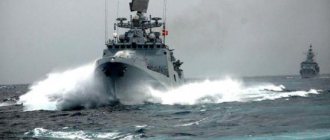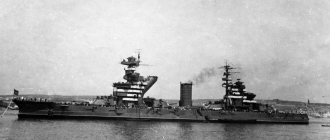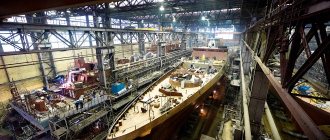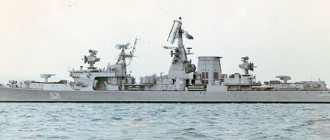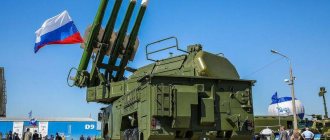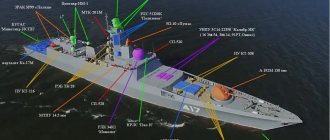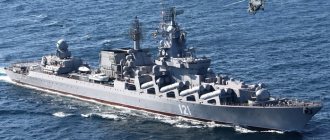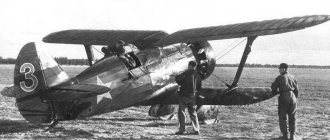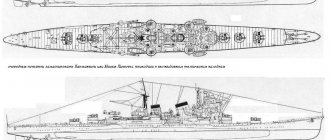For the first time in the USSR, sketches of aircraft-carrying ships began to be created in the 1920s, but their full design and construction began only in the 1960s. Initially, helicopters were based on such ships. Over time, air groups included aircraft, first with vertical takeoff and landing, and later with horizontal takeoff and landing.
In total, seven aircraft-carrying ships were built in the USSR. Their designs were developed by the Nevsky Design Bureau (PKB) in Leningrad (now St. Petersburg). All ships were built at the Black Sea Shipyard in Nikolaev (Ukrainian SSR, now Ukraine).
About Russian and Soviet aircraft-carrying ships - in the TASS material.
Project 1123 (code "Condor")
They were classified as anti-submarine cruisers and served as a base for an air group of 14 Ka-25 helicopters of various modifications. The ships of this project had a standard displacement of 11,100 tons (full - 15,280 tons), length of 189 meters, width of 34 meters.
They were equipped with a two-shaft boiler-turbine power plant with a total capacity of 90 thousand horsepower and reached a speed of up to 29 knots. The cruising range was 6,000 nautical miles (11,100 km), and the navigation endurance was 15 days. Crew - 541 people, of which 131 are officers.
The ship's armament included launchers for the Shtorm anti-aircraft missile system (ammunition - 96 missiles), Vikhr anti-submarine systems (9 missiles) and RBU-6000 rocket launchers (240 bombs), 533 mm torpedo tubes, AK artillery mounts -725 caliber 57 mm.
- The lead ship "Moskva" was laid down under serial number 701 on December 15, 1962, launched on January 14, 1965, and accepted into the fleet on December 25, 1967. Expelled from the fleet on November 7, 1996. Subsequently cut into metal in India.
- The first production ship "Leningrad" under serial number 702 was laid down on July 31, 1966, launched on July 31, 1966, entered the fleet on April 22, 1969, and left it on December 5, 1992. In 1995, cut into metal in India.
- The second production ship (serial number 703, project 1123M/11233, with a length increased by 12 meters) was planned for laying down in 1968, but construction was cancelled.
Combat "Eagle"
The outbreak of the First World War suspended experiments with seaplanes and their carriers, but already on January 9, 1915, the commander of the Baltic Sea Naval Forces, Admiral Nikolai von Essen, sent a note to the Minister of the Navy, Admiral Ivan Grigorovich, in which he outlined the idea of introducing into the Baltic Fleet an “aviation vessel” designed for aerial reconnaissance. According to von Essen's plan, it was supposed to be an auxiliary cruiser with a detachment of seaplanes stationed on it, numbering from four to seven, which it could launch in the designated area. In military conditions, there could be no question of building such a ship from scratch, so it was proposed to re-equip an existing one, for example, a transport mobilized for military needs.
The role of the first domestic hydroair transport was assigned to the steamship “Empress Maria” (formerly “Vologda”), which belonged to the Riga shipping company and made flights to London before the war. They decided not only to mobilize it, but to purchase it for the needs of the Naval Ministry and immediately re-equip it for new tasks, building two canvas hangars on the deck for two seaplanes each and installing four lightweight rotary booms for their lowering and lifting. Such equipment made it possible to spend 12 minutes unloading one airplane and 20 minutes lifting it, which were very decent figures. The only disadvantage could be considered the need to carry out these operations only in slight waves, but, however, at that time the seaplanes themselves did not know how to take off and land on a serious wave.
On April 20, 1915, the auxiliary cruiser of rank II, named "Orlitsa" and classified as a training ship, was assigned to the Baltic Sea communications service. His squadron consisted of four French FBA flying boats (another spare seaplane was stored disassembled in the hold), which were replaced a year later by domestic M-9 flying boats. These seaplanes, designed by Dmitry Grigorovich, differed favorably from the French ones by the presence of a machine gun and the ability to carry bombs on board. It was these flying boats that took part in the first air battle in the history of Russian naval aviation on July 4 (June 21, O.S.), 1916, during which our pilots managed to shoot down one and damage two German hydroplanes, losing one of their own.
Project 1143 (code "Krechet")
Anti-submarine cruisers with aviation weapons served as the base for an air group of 36 Yak-38 carrier-based vertical take-off and landing attack aircraft, Ka-25 and Ka-27 helicopters. The ships of this project had a standard displacement of 30,530 tons (full - 41,370 tons), length 273 meters, width 49 meters.
They were equipped with a four-shaft boiler-turbine power plant with a total capacity of 180 thousand horsepower and reached a speed of up to 31 knots. The cruising range was 8,000 nautical miles (14,800 km), and the cruising autonomy was 30 days. Crew - 1,642 people, of which 384 are officers.
The ship's armament included launchers for the Shtorm air defense system (96 missiles), the Osa-M air defense system (40 missiles) and P-500 Basalt anti-ship missiles (16 missiles), and the Vikhr anti-submarine systems (16 missiles) and RBU-6000 rocket launchers (240 bombs), torpedo tubes of 533 mm caliber, artillery mounts of 76 mm and 30 mm calibers.
- The lead ship "Kyiv" was laid down on July 21, 1970 under serial number 101, launched on December 26, 1972, entered the fleet on December 28, 1975, and withdrawn from it on June 30, 1993. Later sold to a Chinese company, it is currently located in Tianjin (PRC), where it became part of an amusement park and was converted into a hotel in 2011.
- The cruiser "Minsk" was built according to a slightly modified project 11432 (serial number 102). She was laid down on December 28, 1972, launched on September 30, 1975, commissioned on September 27, 1978 and withdrawn from the fleet on June 30, 1993. Subsequently sold to China, in 2006 it became part of an amusement park in Shenzhen .
- The cruiser "Novorossiysk" (project 11433, original name "Baku", serial number 103) was laid down in September 1975, launched on December 26, 1978, entered the fleet on November 24, 1982 and withdrawn from it in 1991, after which was sold for metal to South Korea, where it was dismantled in 1997.
"Imperial" air transport
"Orlitsa" remained the only seaplane carrier ship in the Baltic Fleet. The remaining eleven Russian seaplane transports, which managed to be converted before Russia left the First World War, served in the Black Sea. These were the already mentioned transport "Dnepr", the yacht "Almaz" and the armored cruiser "Cahul", as well as the former passenger ships "Emperor Alexander I" and "Emperor Nicholas I" and converted from Romanian cargo-passenger ships "Dacia", "Emperor Trajan" , "King Charles", "Principessa Maria" and "Romania".
Before the start of the war, both “imperial” hydroair transports belonged to the Russian Society of Shipping and Trade (ROPiT) and sailed on the Black Sea, and then were mobilized and turned into auxiliary class II cruisers. It is noteworthy that one of these cruisers - "Emperor Alexander I" - originally bore the name "Emperor Alexander III", it was renamed after being called up for military service, since a battleship with the same name was already serving in the Black Sea Fleet. Both seaplane transports, along with the Almaz and Romania, at the very end of December 1916, became part of the first real aircraft-carrying formation in the history of the Russian fleet - a detachment (later division) of naval aviation. According to the “Regulations on the Naval Aviation Division” approved at the end of November 1916, it was intended to “operate away from its coastal areas, regardless of permanent coastal air stations” and consisted of thirty-two seaplanes and four ships.
Two ships from the division—the same “imperial” seaplane transports—participated on February 7 (January 23, O.S.), 1916, in the raid on Zonguldak and in other military operations. The Almaz seaplane, which carried on board first two and then four M-5 seaplanes designed by Dmitry Grigorovich, also actively fought. At the very beginning of the war, the former yacht, which became a cruiser of the 2nd rank, participated in the search for the German cruiser Goeben transferred to Turkey, and its seaplanes conducted anti-submarine reconnaissance and performed communications functions. In total, during the First World War, six enemy ships were sunk with the participation of Almaz. The cruisers "Memory of Mercury" and "Cahul", also converted to accommodate seaplanes, fought no less actively, although not as seaplanes, but as ordinary warships. But the Dnepr did not participate in serious operations, since by that time it was already very outdated and served as a training vessel for naval pilots of the Black Sea Fleet.
The fate of the five Romanian cargo-passenger ships transferred to Russia on September 9, 1916, which from the very beginning it was decided to convert into seaplane transports, also turned out differently. Of these, first of all, “Romania” had a chance to participate in serious combat operations, whose M-9 seaplanes in 1917 carried out aerial photography of the Bosphorus fortifications and bombed them, and “Dacia” and “King Charles” in August 1917 supported them with airborne artillery fire and sorties of their own. seaplanes of the Romanian Front operation. The remaining two “Romanian” seaplanes did not have time to take part in the hostilities, and after the revolution, all five ships were returned to Romania.
Project 11434
Classification - heavy aircraft-carrying cruiser (TAVKR). A base for an air group of 36 Yak-38 or Yak-141 carrier-based attack aircraft, Ka-27 helicopters of various modifications. The ship of this project had a standard displacement of 33,000 tons (full - 44,500 tons), length 273 meters, width 29 meters, draft 9.5 meters.
It was equipped with a four-shaft boiler-turbine power plant with a total capacity of 180 thousand horsepower and developed a speed of up to 30 knots. The cruising range was 7,000 nautical miles (13,000 km). Crew - 1,610 people, of which 383 are officers.
The armament included launchers for the Kinzhal air defense system (192 missiles) and P-500 Basalt anti-ship missiles (ASM), RBU-12000 anti-submarine rocket launchers (60 bombs), 100 mm torpedo tubes, AK-630 30 mm anti-aircraft guns , artillery mounts of 100 mm caliber (600 shells).
- The lead and only ship of the project is “Admiral of the Fleet of the Soviet Union Gorshkov” (serial number 104, until January 4, 1990 was named “Baku”), laid down on December 26, 1978, launched on March 31, 1982, entered the fleet on December 20 1987 and withdrawn from it on March 5, 2004. Later sold to India, rebuilt, and commissioned into the Indian Navy as Vikramaditya on June 14, 2014.
"Leverages".
The aircraft carrier, launched in the summer of 1940, did not have the upper part of the tank almost to the deckhouse-island, because Due to the insufficient height of the Russud boathouse, its construction on a slipway was impossible. As a result, by the beginning of the war, the completion of Rychagov was far from complete. The unfinished aircraft carrier was towed to Novorossiysk, and from there to Poti, where it remained until the end of the war. Completion work resumed only in 1947, and “Rychagov” entered service only in 1949 and was immediately sent to the Pacific Fleet.
Project 11435
Heavy aircraft-carrying cruiser. The air group consists of 50 carrier-based fighters (Su-27K, MiG-29K), Ka-27 helicopters of various modifications. A fundamentally new project, which only has a power plant in common with Project 1143. The ship received a through flight deck with a springboard and on-board aircraft lifts, which were used for the first time in Soviet practice.
The “island” superstructure has changed little compared to Project 11434, but the ship’s underwater and surface structural protection has improved and its autonomy has increased.
The standard displacement of the TAVKR project 11435 is 43,000 tons (full - 55,000 tons), length - 304 meters, width - 72 meters, draft - 10 meters.
The four-shaft boiler-turbine power plant has a total power of 200 thousand horsepower. Full speed - 29 knots, cruising range - 8,000 nautical miles (14,800 km), cruising endurance - 45 days. Team - 1,960 people, including 518 officers.
Armament - launchers of the Granit air defense system, Kinzhal air defense system (192 missiles), Kortik air defense system (256 missiles, 48 thousand shells), RBU-12000 anti-submarine rocket launchers (60 bombs).
- The lead ship of the project is the TAVKR "Admiral of the Fleet of the Soviet Union Kuznetsov" (serial number 105, at the project stage it was called "Soviet Union", in 1982 it was named "Riga", in the same year it was renamed "Leonid Brezhnev", in 1987 - 90 years was called "Tbilisi") was laid down on February 22, 1983, launched on December 4, 1985, entered the fleet on January 20, 1991. Currently, it is the largest ship of the Russian Navy and the only aircraft carrier in its composition capable of carrying horizontal take-off and landing aircraft.
- According to a slightly modified project 11436, in 1985-1992, the Varyag TAVKR was built in Nikolaev, which in 1993 went to Ukraine and in 1998 was sold to China. On September 25, 2012, it was adopted by the People's Liberation Army Navy as the Liaoning. Currently, it is the only Chinese aircraft carrier.
Warships. Russian aircraft carriers
This myth still haunts numerous monographs dedicated to the Soviet aircraft carrier fleet. The designers of the “five” themselves claim that the creation of Project 1143.5 was not the result of the evolutionary development of ships of the “Kyiv” type, but the third attempt to implement the design of a real aircraft carrier, which began back in 1971. The requirements for the new ship were revised with kaleidoscopic speed - the composition of the air group, aviation equipment, the number of anti-aircraft weapons and displacement changed. In 1980, the USSR Minister of Defense Dmitry Fedorovich Ustinov (1908–1984) demanded that the displacement of the aircraft carrier being designed be reduced by 10,000 tons, the catapults removed, and its reorientation toward short take-off and landing aircraft, for the launch of which a springboard should be used.
In February 1982, the first Soviet aircraft carrier with a continuous flight deck was laid down in Nikolaev, at the Black Sea Shipyard (ChSZ) under the name “Riga” (serial number S-105). However, a year later it was remortgaged under the new name “Leonid Brezhnev”. Then sea trials were carried out under the name "Tbilisi", but when Georgia declared sovereignty, the ship was given the current name "Admiral of the Fleet of the Soviet Union Kuznetsov". On August 1, 1990, state tests began. During testing, 16,200 miles were covered and 454 aircraft flights were completed. In May 1990, the ship was temporarily included in the 30th division of surface ships of the Red Black Sea Fleet, and on December 25, 1990, eight years, three months and 24 days after laying, the acceptance certificate was signed. On January 20, 1991, it was officially enlisted in the Northern Fleet, and the naval flag was raised on it. On December 1–24, 1991, the cruiser sailed around Europe to its permanent base in Vidyaevo, Murmansk region.
The main technical and technical characteristics are as follows: displacement 55,000 tons, speed 29 knots, length 304.5 m, width at the waterline 38 m, greatest beam 72 m, draft 10.5 m, crew 1,960 people, aviation personnel 626 people. The main power plant is a boiler-turbine unit with a total capacity of about 200,000 liters. With. Armament: 52 aircraft (MiG-29K, Su-27K fighters, Su-25K attack aircraft, Ka-27 helicopters), 12 launchers for anti-ship missiles, eight launchers for anti-aircraft missiles, eight six-barreled 30-mm machine guns, two rocket launchers.
General layout of the aircraft carrier "Admiral of the Fleet of the Soviet Union Kuznetsov"
The ship has a through flight deck, which ends with a ski-jump at the bow. Cable aerofinishers are installed in the aft part of the flight deck - when landing, the aircraft grabs the aerofinisher cable with a hook installed under the fuselage and, experiencing an overload of up to 3.5 g, is slowed down, which reduces the distance after landing to 80–100 m. In the bow of the ship under the deck there are 12 vertical launchers of anti-ship missiles (ASM) "Granit", covered with armored covers flush with the flight deck.
Airplane takeoff from Kuznetsov
The architecture of Project 1143.5 TAKR has become “more aircraft carrier-like” compared to its predecessors - with a through flight deck with an area of 14,800 m², a ski-jump with a landing angle of 14.3° in the bow, two onboard 40-ton aircraft lifts on the starboard side in the bow and stern from the island 13-tier superstructure (height above deck 32 m). The presence of developed sponsons and the displacement of the superstructure to the right made it possible to increase the width of the flight deck to 67 m. The landing section of the flight deck (205 x 26 m), including the left side sponson, is located at an angle of 7° to the ship’s axis. The entire surface of the flight deck and springboard has an anti-slip heat-resistant (up to 450 °C) Omega coating, and three sections (10 x 10 m) intended for vertical landing of the Yak-41 were lined with heat-resistant (up to 750 °C) AK-9FM slabs .
Kuznetsov springboard, jet engine gas deflector raised
The fully welded hull has seven decks and two platforms in height. A continuous double bottom runs along the entire length of the ship. The main structural material of the hull, main watertight bulkheads, decks and platforms, sponsons and island superstructure is steel; Aluminum-magnesium alloys (with fastening to steel structures) were used for the manufacture of secondary partitions and bulkheads. The surface structural protection (SSP) is made according to the shielding principle; composite structures (such as steel-fiberglass-plastic-steel) serve as internal protective barriers. The main material of NKZ is high-strength steel. To protect fuel tanks and aviation ammunition magazines, local box-shaped armor was used. For the first time in the practice of domestic aircraft carrier shipbuilding, underwater structural protection (SSP) was used to increase the survivability of the ship, which significantly increases the unsinkability characteristics. Based on the results of numerous research projects and full-scale experiments, the depth of the onboard PKZ was taken to be in the range of 4.5–5.0 m. Of the three longitudinal bulkheads, the second one was made armored (on the lead ship it was packaged, i.e. multi-layered, on the second - monolithic).
Hangar of TAKR "Kuznetsov"
The hangar is a closed type, with a total area of 3,980 m² (153 x 26 x 7.2 m) - about 50% of the length and 70% of the width of the ship, used for storage and maintenance of up to 70% of the standard number of shipborne aircraft (LAV). It also stores mobile tractors, ship gas-jet and fire engines, as well as a set of means for deck maintenance of the LAC. Transportation and placement of aircraft are provided with folded wing consoles, and helicopters with folded rotor blades. At all regular LAC parking places in the hangar and at technical positions, they are moored and grounded. The hangar is equipped with a semi-automatic system for chain transportation of LAC, which makes it possible to abandon the use of tractors and eliminate the contamination of the interior with exhaust gases. Tractors are required only for operations with LAC on the flight deck, when transporting them from the hangar to the lift platforms and back. The typical composition of the air group based on the Project 1143.5 ship includes 52 aircraft: 18 Su-27K and MiG-29K aircraft each and 16 Ka-27 helicopters.
To ensure the landing of high-speed aircraft on the deck, Svetlana-2 aerofinishers are used - four cables stretched across the deck, located at a distance of 12 m from each other and connected through blocks with four hydraulic brake machines designed to dampen kinetic energy. In the operating position, the cables rise above the deck to a predetermined height to catch the landing aircraft with the brake hook, ensuring its complete stop after 90 m of travel with a longitudinal overload of no more than 4.5 g. The fourth cable, counting from the stern, is combined with the Nadezhda emergency barrier. The cable of the first arresting arrester is located 40 m from the stern. In the middle of the second aero arresting device on the deck there is a white circle with a diameter of 17 m - the place where the aircraft brake hook is recommended for pilots to touch when landing.
The main power plant of the TAKR almost completely replicates that used in project 1143.4: four-shaft, steam turbine, with a total power of 200,000 hp. With. The increased fuel supply made it possible to increase the cruising range to 18 knots. travel up to 8,000 miles. The power was increased due to the installation of new boilers. Thanks to this, with an increase in standard displacement by 10,000 tons, it was possible to achieve a full speed of 29 knots. Steam is produced by eight KVG-4 boilers with increased steam capacity. Steam for needs not related to the movement of the ship is obtained through extraction from the main boilers, so an auxiliary boiler installation was not needed. The ship's propulsors are four bronze low-noise fixed-pitch five-blade propellers with a diameter of 4,260 mm and a mass of 12,524 kg each.
Granin missile silos
The Russian TAKR has powerful missile armament: the Granit-NK missile strike system includes 12 ZM-45 anti-ship cruise missiles placed in below-deck silo-type launchers (the silo covers are made flush with the deck). Anti-aircraft missile weapons - four modules of the Kinzhal air defense system (192 missiles) and eight modules of the Kortik air defense system (256 missiles and 48,000 30-mm shells), located on the side of the sponsons and providing the possibility of all-round firing of air targets. Artillery weapons are represented by three batteries consisting of six 30-mm rapid-fire artillery mounts AK-630M (48,000 rounds). Initially, it was planned to place another battery of these machine guns under the nose edge of the take-off springboard for firing at the nose heading angles. Two embrasure cutouts were intended for their installation (they are clearly visible in photographs of the early stage of construction of the lead ship), but they were abandoned.
Air defense missile and artillery complex "Kortik"
Due to perestroika and the beginning of the collapse of the USSR economy, the commissioning of the ship was greatly delayed. The first landing on the deck of an aircraft carrier was made by test pilot Viktor Georgievich Pugachev (b. 1948) on September 1, 1989, while combat pilots began to master the deck of the Kuznetsov only in 1994 and already in the Northern Fleet. In 1996, the aircraft carrier made its first long-distance voyage from the Barents Sea to the Mediterranean. During the voyage, combat training tasks were practiced; In the Mediterranean Sea, Russian pilots exchanged friendship visits with American colleagues from the air group of the aircraft carrier America, however, the Americans did not dare to land their planes on the deck of the Russian ship and sent a helicopter. From 1996 to 1998 was undergoing renovations, which were greatly delayed as a result of underfunding. In 1998, he took part in major exercises of the Northern Fleet.
In 1999, he went to sea twice for combat training. In 2000, he participated in major exercises, during which the K-141 Kursk submarine was lost, took part in a rescue operation, which caused the cruiser’s second trip to combat service in the Mediterranean Sea, which was supposed to take place at the end of 2000, to be cancelled. From 2001 to 2004 was undergoing scheduled maintenance.
Launch silos of the Kinzhal air defense system
In 2004, as part of a group of nine ships of the Northern Fleet, including the heavy nuclear-powered missile cruiser Pyotr Velikiy, the missile cruiser Marshal Ustinov, the squadron destroyer Admiral Ushakov and support vessels, he took part in a month-long voyage to the North Atlantic. On December 5, 2007, as part of a naval strike group, it went on its second trip to combat service in the Mediterranean Sea, which lasted until February 3, 2008. According to representatives of the Russian Ministry of Defense, the aircraft carrier requires major repairs, but due to lack of finances, repairs have been postponed until indefinite term. The ship's seventh long-distance voyage was completed in May 2014. From May 14 to August 20, 2015, the TAKR was under repair at the dock of the 82nd ship repair plant (Roslyakovo). On November 6, 2016, the TAKR set off on a cruise to the Mediterranean Sea as part of a group of the Northern Fleet.
Currently, the Admiral of the Fleet of the Soviet Union Kuznetsov is part of the Northern Fleet and is the only aircraft-carrying ship of the Russian Navy. During cruises, the cruiser is based on Su-25UTG and Su-33 aircraft of the 279th naval fighter aviation regiment (based airfield - Severomorsk-3) and Ka-27 and Ka-29 helicopters of the 830th separate naval anti-submarine helicopter regiment (based airfield - Severomorsk-1). Thus, this aircraft-carrying cruiser can rightfully be considered a full-fledged aircraft carrier. Not the same, of course, as the American nuclear giants such as the Nimitz, but quite equal in combat potential to, for example, the newest French nuclear aircraft carrier Charles de Gaulle. And in terms of the number of naval air group, Kuzya even has superiority: 52 aircraft versus 40 for the Frenchman.
Airborne aircraft lift TAKR "Admiral of the Fleet Kuznetsov"
In 1983, a decision was made to build a second ship, Project 1143.5, which received the name “Riga” (serial number S-106). The TTZ included the possibility of improving the project in the event of the emergence of new types of weapons and electronic equipment. Its construction began immediately after the launch of the lead TAKR: two 900-ton cranes installed the laying block (bow MKO) of a new order with two GTZA and four main boilers already mounted and covered. The ship was launched on November 25, 1988, and during completion it was renamed “Varyag” (June 19, 1990).
On the deck of a Russian aircraft carrier
Initially, the 6th completely repeated the “five”, but already in June 1986, a decree of the Council of Ministers of the USSR was issued to change some of the main elements of the cruiser, in particular electronic weapons (the ship was assigned the index project 1143.6). Thus, the Mars-Passat radar was to be replaced with a more effective new Forum, consisting of the Podberezovik radar with the ability to select air targets, two Fregat-MA radars and an information processing, target distribution and target designation system of the Poyma type. All this required the alteration of about 150 rooms, mainly in the superstructure. It was also necessary to correct a significant amount of design documentation, which led to a delay in the completion of the cruiser by approximately nine months. In addition, on the Varyag, unlike the lead ship, it was already planned to provide a base for the Yak-44RLD radar patrol and guidance aircraft (with the ability to take off from a distant launch position), which also caused a number of alterations. True, until the end of 1991, this work was not actually started due to the lack of data on the aircraft from the Design Bureau named after. Yakovleva.
“Varyag” was built for the Pacific Fleet with a delivery date of 1993. Even after the collapse of the USSR, until the end of 1991, completion proceeded in accordance with the schedule agreed upon and approved even before the abolition of the former Ministry of Shipbuilding and Industry of the USSR. To ensure the basing of aircraft carriers at ChSZ, they managed to manufacture and send to the Far East a special pontoon-berth, similar to the one that was previously delivered to Vidyaevo for the Admiral Kuznetsov. Taking into account the planned modernization, blocks of premises previously intended for Mars-Passat radar stations were cut off on the superstructure and foundations were installed for the Fregat-MA AP of the Forum radar.
"Admiral of the Fleet of the Soviet Union Kuznetsov" in the Atlantic, 2009
But soon the economic crisis in the former republics of the Union made itself felt at ChSZ - cable supplies by the Amurkabel and Azovkabel enterprises were disrupted, which, in turn, did not receive raw materials from Uzbekistan. Then problems arose with pricing and its impact on the cost of building a ship. Moreover, as always happens during periods of collapse of large states, this was accompanied by collapses in the economy, rising prices and galloping inflation.
Despite the cessation of funding (IV quarter of 1991), the Black Sea Shipbuilding Plant (General Director Yu. I. Makarov) completed the construction of the TAKR at its own expense, hoping that Moscow would later reimburse the costs (more than 700 million US dollars in 1980s prices). . However, the former Soviet republics that became independent did not show any interest in completing the Varyag. Russia, which declared in 1993 that it was ready to complete the ship, also did nothing for this, limiting itself to fruitless negotiations. In particular, regarding the Varyag, it was proposed to create a special intergovernmental body with emergency powers that would coordinate the completion of the cruiser. Government delegations from Ukraine and Russia even came to Nikolaev to inspect it. But none of them, under the new conditions, had the means to complete the construction of such a complex ship.
Therefore, in March 1995, Russia officially refused to finance the construction of the Varyag, transferring it to ChSZ to pay off the company’s debts 1 . Ukraine, after considering various options for dismantling the ship, which was 67% complete, including the possibility of using it as a floating spaceport, was eventually forced to sell the unfinished aircraft carrier abroad. Based on the results of the study carried out in 1997–1998. An international tender, the winner of which was a Chinese company registered in Macau, was sold by the State Property Fund of Ukraine for only 20 million US dollars.
Towing "Varyag" to China
While its fate was being decided, the Varyag continued to remain at the plant, turning at the beginning of 2000 into the “goose that lays the golden eggs” for ChSZ - the Chinese paid the plant $5,000 a day for parking the TAKR. In the first half of 2000, it was expected that a contract would be signed with a Chinese company for the completion and conversion of the Varyag into a floating self-propelled entertainment and tourist complex (the contract amount was expected to be 200–300 million US dollars). But plans changed, and on June 14 at 5.30 am, tugs removed the Varyag from the factory waters and began towing it to China. His further fate will definitely be discussed in the corresponding issue of NiT.
Initially, the cruisers of projects 1143.5 and 1143.6 were supposed to be equipped with steam catapults (one of them was even built and tested on land). But the developers failed to provide the necessary rigidity to the catapult track design, and it turned out to be inoperative. Therefore, as a necessary measure, instead of catapults, the ships received springboards. In the summer of 1982, in Crimea, at the Nitka complex, experimental work began on taking off Su-27 and MiG-29 aircraft from a springboard, which ultimately ended in success.
In the used ski-jump scheme, take-off from the deck is carried out by accelerating the aircraft with its own engines in afterburner mode. At the end of the takeoff run, the plane reaches the springboard, which sets the required angle of climb and makes takeoff somewhat easier. Until the engines reach full thrust, the aircraft is held on the deck by special grips on the landing gear, which are then lowered below the deck in a strictly synchronized manner, making it possible to begin the takeoff run. To reflect the jet stream of an aircraft standing at the start, a protective deflector shield rises above the deck.
"Varyag" at ChSZ in completion
"Kuznetsov" has three launch positions, two of which are located on the deck, one after the other, at a distance of about 85 m. But since take-off is only from a springboard, several aircraft cannot take off at the same time. It is quite natural that to increase the speed of aircraft takeoff, rapid alternation of starts from the left and right positions is used. The speed of alternation is related to the speed of cleaning the deflector shield of the nearest starting position. The lack of catapults did not allow the cruisers to compare with modern US aircraft carriers in the ability to quickly lift an air group into the air on alert. The advantage of American aircraft carriers in this regard is that they are equipped with four catapults for launching aircraft, which are located in pairs at an angle to each other on the bow on a corner section of the deck. This scheme allows aircraft to be lifted into the air with an interval of only 15 seconds between them.
In 1984, the main opponent of aircraft carriers, Ustinov, died. Almost immediately after this, the Nevsky Design Bureau was again entrusted with the design of a nuclear-powered aircraft carrier with increased displacement, more aircraft and steam catapults. Despite the fundamental difference from the Kyiv-class ships, the aircraft carrier still continues to be called the seventh TAKR - project 1143.7. When this ship was laid down at the ChSZ slipway in Nikolaev on November 25, 1988, it received the name “Ulyanovsk”. TTZ for its development in accordance with the weapons program for 1986–1995. The NPKB received it in December 1984. In 1986, the preliminary design was completed and approved, and in 1987, the technical design (chief designer L.V. Belov, then Yu.M. Varfolomeev). In October of the same year, the main elements of ATAKR were approved: an air group consisting of 70 aircraft (Su-27K and MiG-29K fighters, Yak-44RLD radar and guidance aircraft, Ka-27 and Ka-31 helicopters), a ski jump, two catapults, arresting devices , new anti-ship missile system "Bolid" (later replaced by "Granit"), air defense missile system "Dagger", air defense missile system "Kortik", four-shaft nuclear power plant (280,000 kW), total displacement 73,400 tons, full speed 30 knots.
ATAKR was intended to impart combat stability to fleet formations in operationally important sea and ocean areas, as well as to destroy enemy naval groups in cooperation with other naval forces. Externally, it would differ from the ships of Project 1143.5 in the increased main dimensions, the presence of a third aircraft lift (from the stern on the left side), a reduced superstructure in length, and most importantly, the presence of two steam catapults. In general, continuity was maintained - the ship was equipped with a bow take-off ramp.
The creation of ATAKR represented a qualitatively new stage in the development of Soviet military shipbuilding and aircraft carrier fleet. Project 1143.7 ATAKR had no foreign analogues. In terms of aviation equipment, it could be comparable to the American nuclear-powered aircraft carrier J.S., which was then under construction. Washington,” and was superior to it in terms of the availability of strike missiles and anti-aircraft firepower. On the ship, to the maximum possible extent, samples of weapons, mechanisms, equipment and materials previously provided for ships of Project 1143.5 were used. 33 development work was carried out, 11 of which were carried out according to the plans of the Ministry of Defense (Navy and Air Force). The number and range of the naval air group increased. In particular, it was planned to create the Su-27KM multi-purpose aircraft, the Su-27KPP jammer aircraft, the Su-27KRTS target designation and reconnaissance aircraft, the Yak-44PLO anti-submarine aircraft and the Yak-44RLD radar patrol and guidance aircraft. A prototype of the Mayak steam catapult and a prototype of the superheated steam energy complex that ensures its operation, consisting of a boiler unit, steam accumulators and condensers, passed preliminary tests at the Nitka complex and were recommended for operation. In general, according to experts, the new types of weapons of the ship Project 1143.7 should have met the world level of 1995–2000.
General layout of the aircraft carrier "Ulyanovsk" (project)
The ship's power plant was created on the basis of the KN-3 and GTZA-653 PPUs that were mass-produced and successfully operated on the Kirov-class missile cruisers (Project 1144). The introduction of nuclear energy promised to provide significant reductions in fossil fuel consumption, thereby providing the ship with an almost unlimited cruising range, the ability to maintain high speeds for a long time and more than doubling the reserves of aviation fuel and aviation ammunition. Airplane landing conditions were improved due to the absence of the heat plume typical for ships of previous projects with CTU. At the same time, the corrosion of aircraft located on the flight deck was reduced.
The ship was to have the following main dimensions: maximum length - 321 m, waterline length - 280 m, maximum width (with corner deck and transition bridges) - 79.5 m, waterline width - 38 m; side height from the main line to the upper deck amidships - 27.5 m, in the bow - 33 m, overall height - 65.5 m; standard displacement - 62,580 tons.
Model of the aircraft carrier "Ulyanovsk"
The lead ATAKR, named “Ulyanovsk” (serial number S-107, senior builder P. S. Gerasimov), was laid down in Nikolaev on the slipway “O” on November 25, 1988. The slipway period was designed for 36 months, the total duration of construction was 105 months , delivery date to the fleet - 1995. The cost of the order was estimated at 800 million rubles. At Nitka it was planned to begin testing the ejection takeoff of the Su-27K and MiG-29K. In addition, they also planned to complete the construction of the previously mothballed BS-3 block for testing serial models of catapults and arresting devices intended for installation on ships being built by ChSZ.
The slipway work at Ulyanovsk was carried out using progressive technology, with the formation of a hull on the slipway from 27 large blocks weighing up to 1,380 tons, full of mechanisms, devices and equipment. To ensure nuclear shipbuilding at ChSZ, work began on the reconstruction and modernization of the entire production. It was necessary to build a number of special production units; for their placement in the water area of the Southern Bug adjacent to the ChSZ, a fairly large area was washed with sand.
Work on forming the hull on the slipway progressed quite quickly. In total, they managed to install structures with a total weight of about 27,000 tons. At ChSZ, almost everything was ready for the installation of the nuclear power plant; a technical department for special power engineering was formed, responsible for the installation and physical start-up of the nuclear plant. It was planned to mount four reactors on the ship, combined into two 1,400-ton zonal blocks - for the bow and stern engine groups. For their assembly, a floating autonomous workshop with a sliding roof was specially built and installed on the ground at the stern of the slipway “O”. Upon completion of assembly, the blocks were supposed to be lifted by 900-ton cranes and installed on the ship. The bodies of four metal radiation protection tanks were welded, the shell of which was filled with lead. In 1990–1991 ChSZ received reactor vessels, steam generators, pumps, filters and pipelines. One of these blocks was welded, the second was assembled and prepared for welding. There were no problems or delays during the construction of the Ulyanovsk, and the ship could well have been delivered on time. It was also planned to build a second ATAKR (S-108), the laying of which was scheduled for 1992.
By November 1991, the ship's readiness was 17–20%. After the collapse of the USSR and the cessation of funding, the slipway was blocked by the ATAKR corps, which did not allow it to be used for its intended purpose. Based on a real assessment of the situation, on February 4, 1992, an order was issued by the Prime Minister of Ukraine on the disposal of Ulyanovsk, and on February 5, an order was issued by ChSZ to stop work on the order S-107 (and S-108). The dismantling of the hull was completed by November2. Thus, the evolution of domestic aircraft carriers was put to an end... And Russia’s place in the elite club of nuclear aircraft carriers was taken by France, which in 1995 launched its first such ship, the Charles de Gaulle.
Since 1991, the implementation of projects for the construction of aircraft-carrying ships in Russia has been suspended. Around 1990 (1991?) an article “Do we need an aircraft carrier” appeared in Moscow News. This topic was picked up by dozens of “very specialized publications” - “Moskovsky Komsomolets”, “Echo of the Planet”, etc. Only the lazy did not write about it. On their pages, “experts” expressed only one thought - “the new democratic Russia does not need AVs, it’s better with this money...”. The result of this company was a reduction and then a complete collapse of the aircraft carrier program. But this does not mean that in the new conditions there was no reason to have such ships in the Russian Navy. The press noted that after the collapse of the Warsaw Pact, there followed a transfer of the defense efforts of states into the interethnic space.
"Ulyanovsk" on the slipway, 1990
As is known, the length of Russia’s maritime borders is 38.8 thousand km (for comparison, the length of the land border is 14.5 thousand km), the area of the continental shelf is 4.2 million km2. Along the entire maritime border there is a 200-mile exclusive economic zone with an area of more than 6.3 million km2, in which the sovereign rights and jurisdiction of the Russian Federation and the protection of its interests must be ensured.
In these gigantic sea and ocean expanses, naval forces, ships of various purposes, classes, types, including aircraft carriers, must be constantly or periodically (on call, with aggravation of the situation, etc.). That is why, taking into account the increasingly increasing shortage of organic types of ship fuel in the near future, we will have to admit that there is no alternative to nuclear power plants for the military shipbuilding of industrially and economically developed countries for the next few decades. Of course, ship-based nuclear power plants require a high level of maintenance, strict compliance with nuclear safety requirements (structural, operational, environmental, etc.). Such experience and, most importantly, a system for operating nuclear power plants in the Navy and the country’s icebreaker fleet exist.
Complex "Nitka" in Crimea
The most important factor is the quantitative composition of the aircraft fleet and the types of its aircraft. And this is perhaps one of the main problems for the construction of Russian aircraft carriers.
We remind you that in our journal “Science and Technology” you will find many interesting original articles about the development of aviation, shipbuilding, armored vehicles, communications, astronautics, exact, natural and social sciences. On the website you can purchase an electronic version of the magazine for a symbolic 60 rubles/15 UAH.
In our online store you will also find books, posters, magnets, calendars with aircraft, ships, tanks.
Found a typo? Select a fragment and press Ctrl+Enter.
Tags: Navy
Previous article Fleet in the 21st century. Navy of the Russian Federation. Missed Opportunities
Next article The Fifth Squadron and Judgment Day. Part 1
Provided by SendPulse
Likes 0
Project 11437
In the mid-1980s, the Nevskoye Design Bureau developed a project for a heavy aircraft-carrying cruiser with a nuclear power plant, steam catapults on the corner deck, a take-off ramp and three aircraft lifts.
- The lead ship of Project 11437, Ulyanovsk, was laid down on November 25, 1988. It was to become the flagship of the Soviet Navy and the first of four cruisers of the same type. After the collapse of the USSR in 1991, production was discontinued, and the ship was dismantled on the slipway in 1992.
Project 54 aircraft carriers.
The design of new aircraft carriers began immediately after the completion of the Red Aviator tests. The project, numbered 54, was initially intended to be unified in hull and MKO with the Project 55 heavy cruiser being designed simultaneously, but the increase in air group required by the military in a standard displacement of 10,000 tons could not be achieved. As a result, it was increased to 15 thousand tons, but the reduction in speed, which was considered unacceptable, forced the transition to a three-shaft power plant, which in turn forced the displacement to increase again.
The planes were located in three single-story hangars connected to each other by sliding gates. There were two elevators to lift aircraft onto the deck.
The artillery armament, according to the preliminary design, consisted of 4x2 152-mm and 4x2 102-mm turret installations located on the sides, but soon the 152-mm guns were replaced by 102-mm, which, in conditions of escorting aircraft carriers by artillery ships, was considered sufficient to repel torpedo attacks . The original intention to book the upper deck was abandoned so as not to increase the already increased displacement.
Displacement: 18,500 t (standard), 23,860 t (full).
226.5 (on deck 240.0) x 23.0 (on deck 33.0) x 6.6 m.
Design armament: 8x2 102 mm/55, 8x4 37 mm.
Armor: belt 80 mm, deck (above the citadel) 50 mm.
165,000 hp 34 knots.
The first aircraft carrier of the new project, called Chkalov, was laid down at the Admiralty Shipyard (Galerny Island) in the summer of 1937. A year later, the same type of “Rychagov” was laid down at Russud, and in the fall of 1938, in Molotovsk, “Gromov”.
The program to build new aircraft carriers was nearly derailed when Project 54 came under fire for its insufficient hangar protection from attack aircraft, resulting from experience gained during the Spanish Civil War. It was proposed to stop their construction and start developing a new, better armored project. However, the persistence of N.G. Kuznetsov, who wanted to get new aircraft carriers as quickly as possible, prevailed and the construction of the “fifty-fourths” was continued after a short break. The decision turned out to be correct - the Project 95 aircraft carrier Levanevsky was laid down in Molotovsk only in 1940 and was dismantled on the slipway after the start of the war.
Due to the unavailability of standard artillery weapons, during completion of the Project 54 aircraft carriers, shield-mounted twin 102-mm universal installations were installed, which, after the completion of the manufacture of the towers, were to be transferred to the patrol ships under construction, and twin 37-mm machine guns.
Russian developments
No aircraft-carrying ships were built in Russia. In the 2010s, the Krylov State Scientific Center (KGSC, St. Petersburg) developed a preliminary design of the multi-purpose heavy aircraft carrier "Storm" (project 23000, code "Lair") with a displacement of 100,000 tons, which would accommodate an air group of up to 90 aircraft and helicopters. A model of the ship was demonstrated in the summer of 2015 at the International Naval Show in St. Petersburg. General Director of the Nevsky Design Bureau Sergei Vlasov estimated the cost of building such a ship at 200-280 billion rubles.
In addition, the KGNTs and Nevsky Design Bureau are designing several types of landing helicopter-carrying dock ships (DVKD), these projects are coded “Priboy”, “Avalanche” and “Sperm Whale”.
